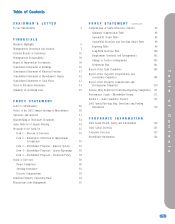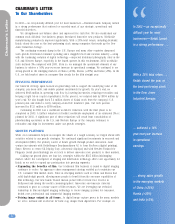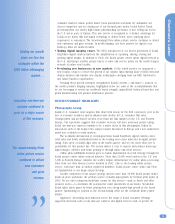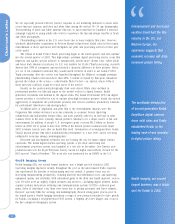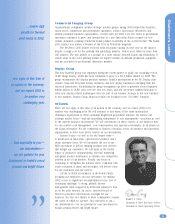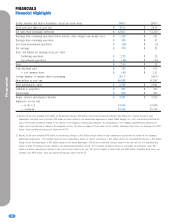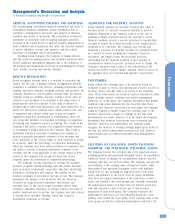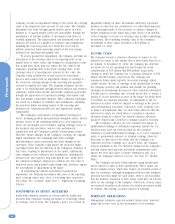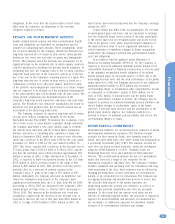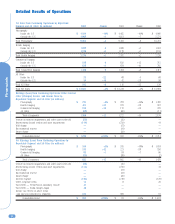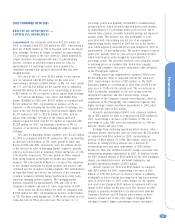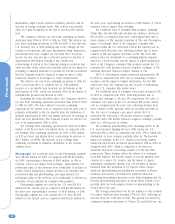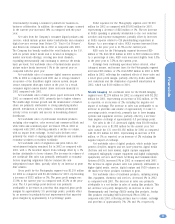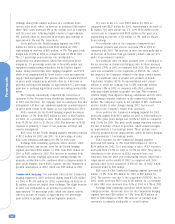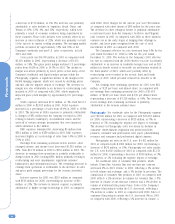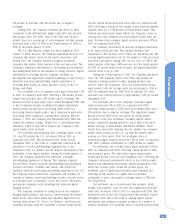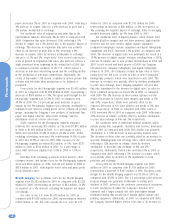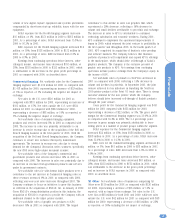Kodak 2002 Annual Report Download - page 9
Download and view the complete annual report
Please find page 9 of the 2002 Kodak annual report below. You can navigate through the pages in the report by either clicking on the pages listed below, or by using the keyword search tool below to find specific information within the annual report.
Financials
9
obligations. In the event that the actual results of these items
differ from the estimates, an adjustment to the warranty
obligation would be recorded.
PENSION AND POSTRETIREMENT BENEFITS
Kodak’s defined benefit pension and other postretirement benefit
costs and obligations are dependent on assumptions used by
actuaries in calculating such amounts. These assumptions, which
are reviewed annually by the Company, include the discount rate,
long-term expected rate of return on plan assets, salary growth,
healthcare cost trend rate and other economic and demographic
factors. The Company bases the discount rate assumption for its
significant plans on the estimated rate at which annuity contracts
could be purchased to discharge the pension benefit obligation. In
estimating that rate, the Company looks to the AA-rated corporate
long-term bond yield rate in the respective country as of the last
day of the year in the Company’s reporting period as a guide. The
long-term expected rate of return on plan assets is based on a
combination of formal asset allocation studies, historical results
of the portfolio and management’s expectation as to future returns
that are expected to be realized over the estimated remaining life
of the plan liabilities that will be funded with the plan assets. The
salary growth assumptions are determined based on the
Company’s long-term actual experience and future and near-term
outlook. The healthcare cost trend rate assumptions are based on
historical cost and payment data, the near-term outlook and an
assessment of the likely long-term trends.
The Company evaluates its expected long-term rate of return
on plan asset (EROA) assumption annually for the Kodak
Retirement Income Plan (KRIP). To facilitate this evaluation, every
two to three years, or when market conditions change materially,
the Company undertakes a new asset liability study to reaffirm
the current asset allocation and the related EROA assumption.
Wilshire Associates, a consulting firm, completed a study (the
Study) in September 2002, which led to several asset allocation
shifts and a decrease in the EROA from 9.5% for the year ended
December 31, 2002 to 9.0% for the year ended December 31,
2003. This factor, coupled with a decrease in the discount rate of
75 basis points from 7.25% for 2002 to 6.5% for 2003, and the
fact that the transition asset, which provided approximately $56
million of income in 2002, is fully amortized as of December 31,
2002, is expected to lower total pension income in the U.S. from
$197 million in 2002 to pension income in the range of $49
million to $59 million in 2003. This decrease in income will be
partially offset by a decrease in pension expense in the
Company’s non-U.S. plans in the range of $53 million to $65
million. Additionally, the Company increased its healthcare cost
trend rate assumption with respect to the Company’s most
significant postretirement plan, the U.S. plan, from 9% for 2003,
decreasing to 5% by 2007 (as discussed in the Company’s 2001
Annual Report on Form 10-K), to 12% for 2003, decreasing to
5% by 2010. This increase in the healthcare cost trend rate
assumption, coupled with the decrease in the discount rate, is
expected to increase the cost of this plan from $222 million in
2002 to a range of $254 million to $310 million in 2003. All
these factors have been incorporated into the Company’s earnings
outlook for 2003.
Actual results that differ from our assumptions are recorded
as unrecognized gains and losses and are amortized to earnings
over the estimated future service period of the plan participants
to the extent such total net recognized gains and losses exceed
10% of the greater of the plan’s projected benefit obligation or
the market-related value of assets. Significant differences in
actual experience or significant changes in future assumptions
would affect the Company’s pension and postretirement benefit
costs and obligations.
In accordance with the guidance under Statement of
Financial Accounting Standards (SFAS) No. 87, the Company is
required to record an additional minimum pension liability in its
Consolidated Statement of Financial Position that is at least equal
to the unfunded accumulated benefit obligation of its defined
benefit pension plans. In the fourth quarter of 2002, due to the
decreasing discount rates and the weak performance of the global
equity markets in 2002, the Company increased its net additional
minimum pension liability by $577 million and recorded a
corresponding charge to accumulated other comprehensive income
(a component of stockholders’ equity) of $394 million, net of
taxes of $183 million. If discount rates and the global equity
markets’ performance continue to decline, the Company may be
required to increase its additional minimum pension liabilities and
record further charges to stockholders’ equity in the future.
Likewise, if discount rates increase and the performance of the
global equity markets improve, the Company could be in a
position to reduce its minimum pension liability and reverse the
corresponding charges to equity.
ENVIRONMENTAL COMMITMENTS
Environmental liabilities are accrued based on estimates of known
environmental remediation exposures. The liabilities include
accruals for sites owned by Kodak, sites formerly owned by
Kodak, and other third party sites where Kodak was designated as
a potentially responsible party (PRP). The amounts accrued for
such sites are based on these estimates, which are determined
using the ASTM Standard E 2137-01 “Standard Guide for
Estimating Monetary Costs and Liabilities for Environmental
Matters.” The overall method includes the use of a probabilistic
model that forecasts a range of cost estimates for the
remediation required at individual sites. The Company’s estimate
includes equipment and operating costs for remediation and long-
term monitoring of the sites. Such estimates may be affected by
changing determinations of what constitutes an environmental
liability or an acceptable level of remediation. The Company has
an ongoing monitoring and identification process to assess how
the activities with respect to the known exposures are
progressing against the accrued cost estimates, as well as to
identify other potential remediation sites that are presently
unknown. To the extent that the current work plans are not
effective in achieving targeted results, the proposals to regulatory
agencies for desired methods and outcomes of remediation are
not acceptable, or additional exposures are identified, Kodak’s
estimate of its environmental liabilities may change.

